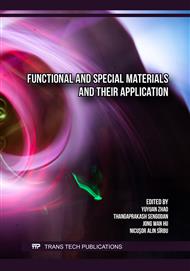[1]
Hapchenko S.A. (2013). Calculation of cable-stayed structures by numerical method. A collection of scientific papers (mechanical engineering, construction) of PoltNTU, 4(39). Vol.1. 64–70.
Google Scholar
[2]
Storozhenko L.I., Yermolenko D.A. (2017). Calculation of a stress-strain state of cable-stayed structures. Collection of scientific works of the Ukrainian State University of Railway Transport, 174. 33–42.
DOI: 10.18664/1994-7852.174.2017.127581
Google Scholar
[3]
Morhun A.S., Soroka M.M., Met I.M. (2016). Features of calculation of "cable-stayed bridge" structures by means of CAD. Visnyk of the Vinnytsia Polytechnic Institute, 4. 7–11.
Google Scholar
[4]
DSTU-N B EN 1993-1-11:2012 Eurocode 3. Design of steel structures. Part 1-11. Design of structures with tension components (EN 1993-1-11:2006, IDT). [Valid from 01.07.2013]. Official Publication. Kyiv: State Committee for Technical Regulation and Consumer Policy, 28 p.
Google Scholar
[5]
Kolosov D.L. Justification of parameters and designs of two-layer rubber-cable conveyor belts for mining enterprises. PhD. Thesis. Dnipropetrovsk, 2002. 164 p.
Google Scholar
[6]
Volokhovskiy V.Yu., Radin V.P., Rudyak M.B. (2010). Concentration of forces in cables and carrying capacity of rubber-cable conveyor belts with damages. MEI Bulletin, (5). 5–12.
Google Scholar
[7]
Belmas I., Kolosov D. (2011). The stress-strain state of the stepped rubber-rope cable in bobbin of winding. Technical and Geoinformational Systems in Mining. Taylor & Francis Group, London, UK. 211-214.
DOI: 10.1201/b11586-35
Google Scholar
[8]
Ropay V.A. (2016). Mine Balancing Ropes: Monograph. Dnipropetrovsk: National Mining University. 263 p.
Google Scholar
[9]
Bondar N.V. (2019). Dissertation for obtaining the scientific degree of Candidate of Technical Sciences in the specialty 05.07.02 – Design, production and testing of aircraft. National Aviation University of the Ministry of Education and Science of Ukraine, Kyiv. 150 p.
Google Scholar
[10]
Lepikhin P., Romashchenko V. (2013). Methods and results of analysis of stress-strain state and strength of thick-walled anisotropic cylinders under dynamic loading. Problems of Strength, 3. 24–41.
DOI: 10.1007/s11223-013-9441-6
Google Scholar
[11]
Seung-Bum Kwak, Nak-Sam Choi (2009). Micro-damage formation of a rubber hose assembly for automotive hydraulic brakes under a durability test. Engineering Failure Analysis, Vol. 16. 1262–1269.
DOI: 10.1016/j.engfailanal.2008.08.009
Google Scholar
[12]
J.R. Cho, Y.H. Yoon, C.W. Seo, Y.G. Kim. (2015). Fatigue life assessment of fabric braided composite rubber hose in complicated large deformation cyclic motion. Finite Elements in Analysis and Design, Vol. 100. 65–76.
DOI: 10.1016/j.finel.2015.03.002
Google Scholar
[13]
Larin O.O. (2016). Predicting reliability of rubber-cord high-pressure pipeline couplings. Bulletin of the Khmelnytskyi National University, 4(239). 40–46.
Google Scholar
[14]
Tkachuk M.M. (2021). Development of statistically averaged models of deformation of materials with a random network structure of differently oriented fibers. Bulletin of the National Technical University "KhPI". Series: Mechanical engineering and CAD, 2. 94–127.
DOI: 10.20998/2079-0775.2021.2.13
Google Scholar
[15]
Humeniuk R.V., Kernytskyi I.S., Sholudko Ya.V., Burtak V.V., Berezovetskyi S.A. (2020). Study of strength of glued composite joints with thermostressed reinforcement. Bulletin of the KHNADU, issue 88, vol. 1. 143-153.
Google Scholar


